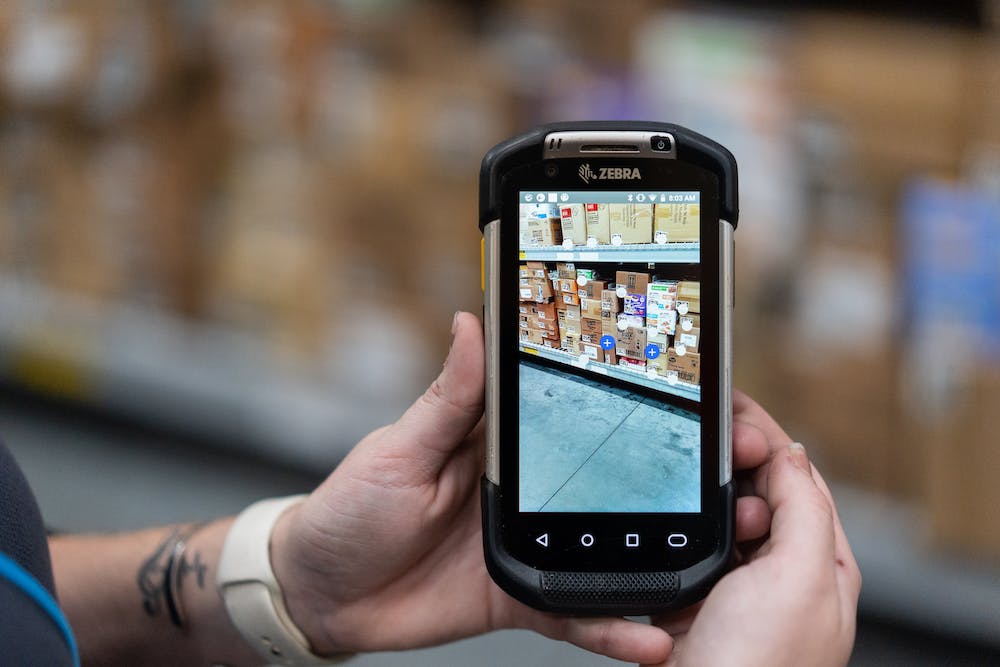The global AR market is projected to grow from $6.12 billion in 2021 to reach $97.76 billion by 2028.
The Covid-19 pandemic has undoubtedly accelerated investment of late, driven by the greater need for companies to deepen customer relationships via digital platforms.
Within the context of marketing, augmented reality allows brands to offer unique and immersive digital experiences, and to engage consumers in a memorable way. Here’s a list of some of the brands to create AR-based experiences in recent times, and what they achieved from doing so.
A Marketer’s Guide to Augmented Reality (AR)
1. Walmart – testing AR for inventory
In October 2020, Walmart announced that it would be turning four of its physical retail stores into ‘test stores’ for the purpose of trying out new technology (with the aim of enhancing all stores to become both physical shopping destinations and online fulfilment centres).
An important element of these stores is inventory control, with one test involving an app that is designed to speed up the time it takes to transport items from the backroom to the sales floor. The app uses augmented reality to do so, allowing employees to hold up a handheld device (which will then highlight the boxes ready to go), rather than scanning each individual box.
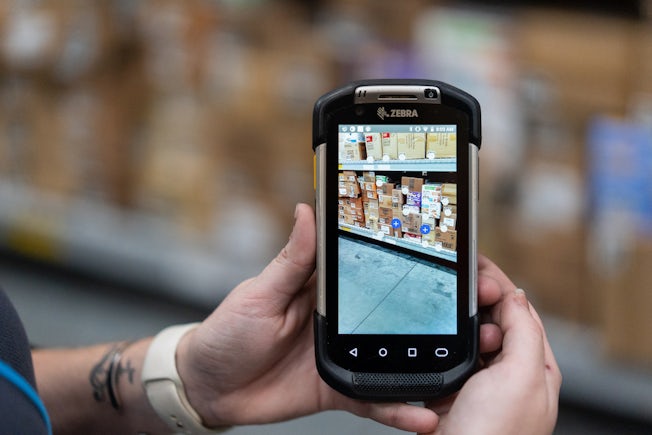
Image: Corporate.walmart.com
This is one example of augmented reality being used to enhance internal processes, effectively creating a more seamless and faster workflow. Despite not being visible to customers, Walmart says that “regardless, it’s the customer who will benefit”, with the technology ultimately helping to enhance the customer experience by putting more products on shelves, faster than before.
2. Snap – City Painter
In October 2020, Snap unveiled ‘City Painter’ in London’s Carnaby Street. The AR tool enables users to virtually spray paint above the street’s shops, decorating them with pre-created murals. One of the most unique aspects of ‘City Painter’ is that it is a shared augmented reality experience, meaning any changes that a person makes is seen in real-time by others using it.
‘City Painter’ is the first major example of Local Lenses – Snap’s ambition to create a shared virtual world by mapping major landmarks. In a promotional video the company explains that by “using various sources of data, 360-degree images, and community snaps – we are able to build up a digital representation of the physical world.”
As the tool progresses, there will undoubtedly be potential for brands to get involved, particularly tourism or travel brands that want to capitalise on the renewed consumer desire for exploration and adventure.
3. ASOS – ‘See My Fit’
Asos is no stranger to mobile innovation, having previously integrated visual search into its highly usable mobile app. By 2019, Asos had fully got on board with AR, launching an experimental AR feature called Virtual Catwalk, designed to help app users visualise 100 Asos Design products.
As the pandemic hit in 2020, models and photographers were forced to work from home, resulting in Asos’ decision to scale up use of ‘See My Fit’ technology – which uses augmented reality to ’digitally fit’ clothing onto models.
As well as allowing Asos to solve a pressing issue – enabling the website to be rapidly updated with new inventory on a weekly basis – ‘See My Fit’ also serves to enhance the customer experience, by showing shoppers how products realistically look in different sizes and on different body types. In turn, this experience can help to drive sales as well as reduce returns.
Asos’ digital innovation has certainly contributed to its success over the past 18 months, culminating in revenues jumping 24% in the six months to the end of February 2021.
Love the new @ASOS see my fit tool. SO helpful, please roll it out to all of your new collections!
— Katy B (@katybarrass_) January 26, 2020
4. Pull & Bear – video game
Inditex, the owner of retail brand Pull & Bear, has launched ‘Pacific Game’ – an AR game created in collaboration with Facebook’s ‘Creative Shop’. The game involves a virtual trip from California to Tokyo, during which users then move their heads in order to dodge obstacles and collect points along the way.
Largely designed for social media, the game is available to play through Instagram and Facebook as well as the retailer’s own website. On Instagram, specifically, users can play through Instagram’s front camera feature.
While luxury fashion retailers like Gucci and Moschino have already expanded into the gaming market, this marks one of the first examples of a more affordable brand doing so, with the aim of reaching the 90% of Generation Z who are also gamers.
5. Burberry – Olympia Pop Up at Harrods
Retail brands are re-imagining AR experiences in order to bring customers back to stores, post-pandemic. Burberry is one such example, recently launching a pop-up AR experience in Harrods to coincide with the launch of its new Olympia bag. Using a QR code found in-store, customers will be able to watch the Elphis statue walk around in their surroundings, as well as take a photo or video to share with friends.
While this type of experience has certainly been done before – and adds little more than a bit of immersive excitement to the shopping experience – AR has taken on a new importance for both brands and consumers in the wake of Covid-19. And the hope is that it will draw luxury consumers back into physical stores as lockdown measures lift.
According to Burberry, “the experience is the latest in a series of activations exploring the relationship between physical and digital experiences to create exciting new concepts for our community and enhance the luxury experience.”
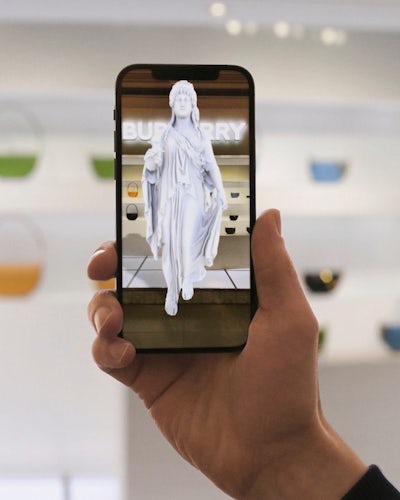
Image: Burberry
6. IKEA Studio app
Ikea’s design lab, Space10, recently revamped Ikea’s AR offering to create a more functional and immersive experience.
Previously, the Ikea Place app allowed users to place virtual furniture in a room. Now using LiDAR sensors in iPhones, the all-new Ikea Studio app enables users to capture entire 3D room plans and re-design them, incorporating everything from windows and door frames to wall colours and rugs.
Currently in beta, Ikea Studio is not yet linked to the Ikea website, meaning it offers a somewhat siloed user experience (with no shopping functionality involved). According to Wired, however, this version of Ikea Studio was largely built in preparation for the arrival of Apple Glass, which could create a more immersive and realistic AR experience.
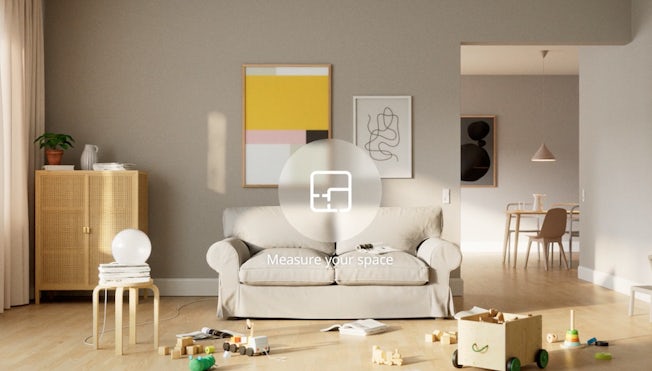
Tommy Campbell, digital design lead at SPACE10, told Wired: “We’ve made very deliberate decisions to paint the vision of Studio as one that can exist on both the smartphone or in a glasses-like setting. We’ve also used a new renderer reality kit from Apple that lets us achieve a level of detail on these models that hasn’t been seen before in IKEA’s AR portfolio.”
7. Amazon – hair colouring at Amazon Salon
Amazon Salon, the ecommerce giant’s first-ever bricks-and-mortar hair salon, was partly set up to trial new retail technology. One example is ‘Point and Learn’, which as Amazon explains, means “customers can simply point at the product they are interested in on a display shelf and the relevant information, including brand videos and educational content, will appear on a display screen.” In order to then buy the products, customers can scan the relevant QR code on the shelf to visit the product page on the ecommerce site.
In addition to this tool, customers will also be able to experiment with different hair shades using AR technology, before actually getting their hair done.
As well as being a way to drive sales of its professional beauty products, the Amazon Salon is largely a vehicle for testing AR technologies (which Amazon could implement in other retail locations), and a way of gathering unique customer data that could also be applied on its ecommerce site.
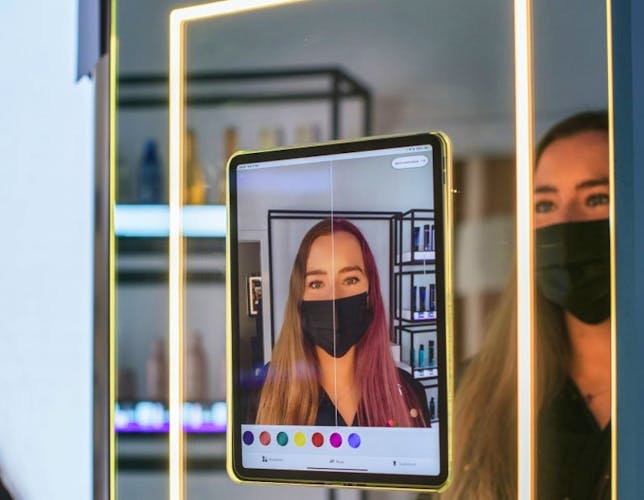
Image: Amazon
8. Gucci – virtual sneakers
One of the main reasons retail brands have invested in AR technology is to help customers make better and more informed product decisions. Gucci was one of the first luxury brands to do so, adding an AR feature to its app to let users ‘try on’ sneakers. This is a highly functional example of AR for retail; by giving customers a visual representation of how a product will look in real life, the technology can theoretically reduce returns and boost customer satisfaction.
More recently, Gucci has released a pair of virtual sneakers, which are designed to only be worn and shared online. The ‘digital-only’ trainers, created in collaboration with AR fashion platform Wanna, can be bought via the Gucci app for $17.99, making it an accessible way for consumers to get their hands on the luxury brand.
Building on the rise in popularity of both virtual influencers and AR filters on social media, this is one of the first examples of ‘digital fashion’ – a concept that some predict will soon take off. Sergey Arkhangelskiy, CEO of Wanna, told Business of Fashion that “in five or maybe 10 years, a relatively big chunk of fashion brands’ revenue will come from digital products.”
Rolling up the door to the #GucciSneakerGarage, a new destination on the Gucci App, features a mix of storytelling, gaming, and a virtual gallery of #Gucci sneakers recreated by a mix of talents, discover more https://t.co/pYjWc7irwm. pic.twitter.com/Ir0lnZkaSf
— gucci (@gucci) November 1, 2020
9. Wayfair – ‘View in Room’
Ikea isn’t the only furniture retailer to heavily invest in augmented reality. In September 2020, Wayfair announced the release of an enhanced version of its ‘View in Room’ app, also using LiDAR technology to combine “enhanced utility and heightened delight when shopping for products for the home.”
Alongside LiDAR, Wayfair has added RealityKit to give users a more realistic and authentic view, for example enabling them to view products cast in accurate lighting (based on real-time). Additionally, the new version enables users to stack products and stand in front of products like they would in the real world, effectively creating a personalised experience.
For furniture retailers, AR can be hugely effective in driving sales. According to Apple, consumers are 11 times more likely to buy furniture if they have had the opportunity to see how it looks in their home using AR. Wayfair has certainly seen some proof of this, with the retailer reporting that customers are 3.4 times more likely to buy when using the technology.
10. Machine A – virtual concept store
Machine-A is a London-based concept store, which is usually dedicated to showcasing contemporary fashion design. With this year’s London fashion week either cancelled or limited to digital shows, Machine-A came up with a concept to enable as many people as possible to view the work of emerging designers.
The idea was a virtual boutique, which as ShowStudio states, aimed to “bring an immersive spin to a digital season of shows, bridging the space between IRL and URL.”
By scanning a QR code embedded in posters and billboards located around London, mobile users were able to ‘enter’ the virtual boutique and explore the new collections of designers. Matthew Drinkwater, head of the Fashion Innovation Agency, told Vogue Business that AR in this context helps to build “a much closer bond between the consumer and brand, at a time when it’s very difficult to foster that.”
While this example is mostly about awareness and engagement – as there’s no integrated shopping functionality – it does hint at how AR could enhance the ecommerce experience in future, essentially creating virtual boutiques for customers to both browse and buy in an entirely immersive way.
11. Sephora – Virtual Artist
Cosmetics retailer Sephora’s ‘Virtual Artist’ tool has been available via its main app since 2016, and it remains one of the slickest examples of AR within beauty. In recent times, of course, Sephora has been encouraging usage as a replacement for in-store shopping.
Instead of furniture in homes, the AR technology lets consumers see what certain products (such as lipstick or eyeshadow) might look like on their own face. To do so, it uses Modiface technology to scan lips and eyes, before overlaying different lip colours, eye-shadows, false lashes and so on.
The main aim of the app seems to be to boost ecommerce sales, with beauty consumers typically driven in-store due to doubts about what products will look like in real life.
Some might say it is no match for trying products on actual skin, but the benefit of the tool is how many different products users can try out – without the hassle or time-consuming nature of doing it in real life. Meanwhile, it also serves as a bit of fun for consumers and yet another way for beauty brands like Sephora to provide entertainment and inspiration as well as the products themselves.
Playing with Sephora Virtual Artist. It’s so lit as!
pic.twitter.com/WZV3kF7diU
— Sha (@shafawatimkthr_) July 29, 2017
12. Kohl’s – virtual closet with Snapchat
With retail stores shut during the pandemic, many brands turned to AR in order to help consumers visualise products or ‘try before they buy’.
Kohl’s is one good example, with the US retail chain teaming up with Snapchat in spring 2020 to update its ‘virtual closet’ with lockdown-appropriate clothing such as athleisurewear.
Accessed via the Kohl’s snapcode or through the lens carousel, the virtual closet allows users to browse clothing as well as mix and match virtual outfits, as well as purchase directly on Snapchat itself.
With Snapchat’s Q1 2020 results showing a 20% year-on-year increase in daily active users, Kohl’s AR campaign aimed to capitalise on the spike in social media usage, as well as the increased desire to browse and shop for clothing on digital platforms.
13. Modiface on Amazon
L’Oréal’s Modiface is one of the best-known examples of AR within retail, with the feature allowing customers to digitally try on make-up through the brand’s app. L’Oréal has also rolled out Modiface to Amazon customers on mobile, allowing them to also digitally overlay make-up looks onto live photos and videos.
For customers, the technology provides much more certainty over what they’re buying (a product that suits the individual’s skin-tone). It also marks a big opportunity for Amazon as a player in the beauty industry, following on from the retail launching its own beauty line, ‘Belei’.
Happi: “ModiFace, the international leader in AR and AI for the beauty industry, which was acquired by L’Oréal in 2018, will now provide its AI-powered tech to enable the first virtual try-ons for cosmetics on Amazon.”https://t.co/mIKShcEY47 pic.twitter.com/WkDOIdfnkv
— ModiFace (@ModiFace) June 11, 2019
14. Adidas – more virtual sneakers
Adoption of AR try-on technology has massively increased as a result of Covid-19, but Adidas was one of the first brands to introduce it – just a few months before the pandemic hit.
In November 2019, Adidas added the feature to its iOS app, helping shoppers to decide on a purchase without ever entering a store – something that was soon to become unavoidable for all consumers. Created in partnership with computer vision platform, Vyking, the AR app tracks foot movements, enabling users to see how sneakers look on their feet in real-time, with or without shoes.
Digital Transformation: Agility and Innovation Best Practice Guide

